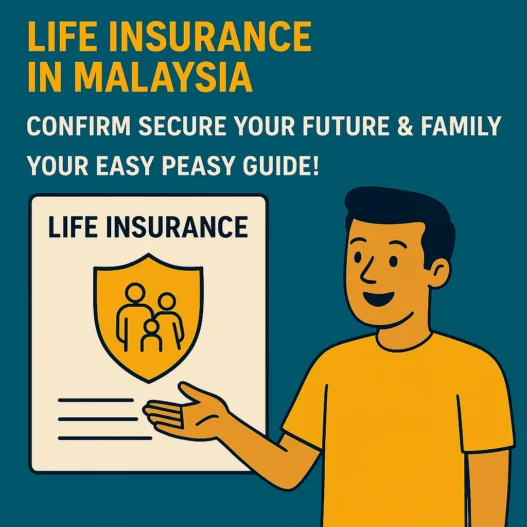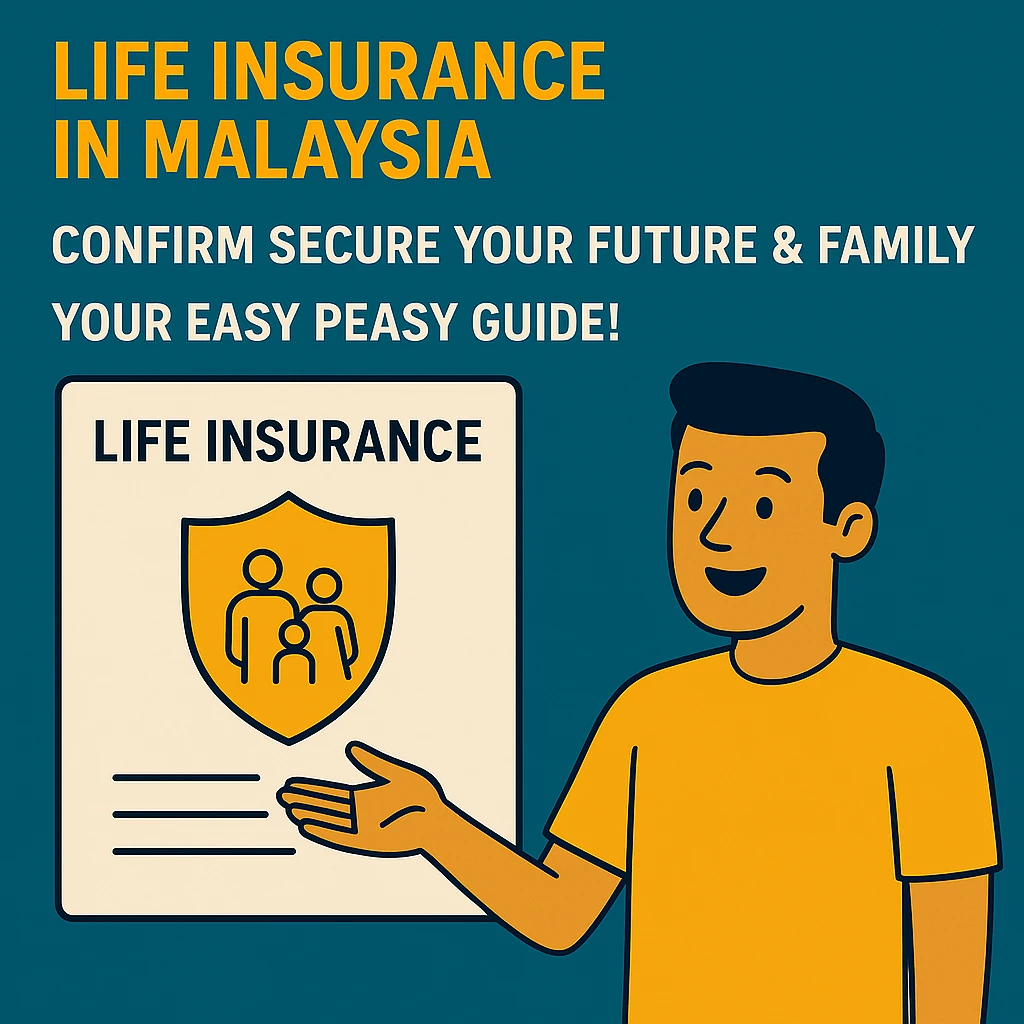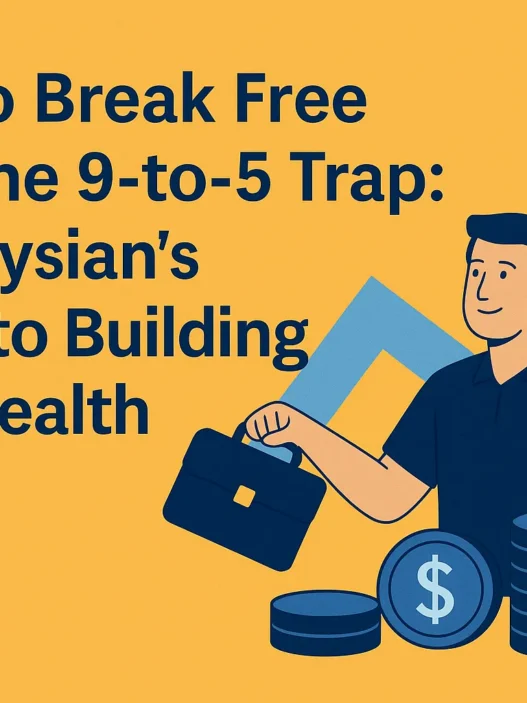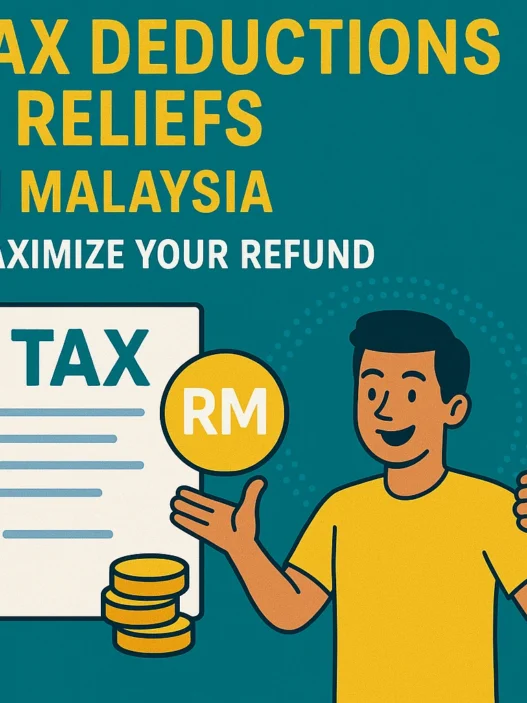Ever find yourself scrolling through social media, seeing friends post about their new homes in Cyberjaya, adorable baby milestones, or even that well-deserved holiday to Langkawi, and a little thought pops up: “Am I doing enough to secure all this?” You’re not alone! Especially for us young professionals, new parents, or even savvy singles in Malaysia, thinking about the future can feel like trying to predict the next big food trend – exciting but a bit overwhelming, kan?
Life in Malaysia is vibrant and full of opportunities. We’re working hard, building careers, maybe starting families, and trying to keep up with the rising cost of living, especially if you’re in KL, Penang, or JB. But what happens if the unexpected, the ‘what ifs,’ throw a spanner in the works? That’s where life insurance comes in – it’s not just some boring financial product your parents nagged you about. Think of it as your financial superhero cape, ready to swoop in and protect your loved ones and your hard-earned stability if you’re no longer around or unable to provide.
Many Malaysians are actually underinsured. A study by the Life Insurance Association of Malaysia (LIAM) highlighted a significant protection gap, with many families potentially facing financial hardship if a primary earner passes away. This guide is here to cut through the jargon, answer your burning questions (“Term life or whole life, ah? How much is enough? Got tax relief or not?”), and help you choose the right life insurance in Malaysia. Consider this your friendly financial GPS for navigating the world of life insurance, so you can make informed decisions with confidence.
“Securing your future isn’t about predicting it; it’s about preparing for it. Life insurance is a cornerstone of that preparation.”
Step 1: Learn the Basics – Term Life vs. Whole Life Insurance: Which One is Your Teh Tarik?
Understanding the two main types of life insurance is the first step. The most common options are Term Life Insurance and Whole Life Insurance, each with distinct features, advantages, and drawbacks. Think of it like choosing your daily cuppa – sometimes you want something straightforward and quick (like a Kopi O), other times something that lasts longer and offers more (like a rich, frothy Cappuccino).
Term Life Insurance: Straight-Up Protection, Macam Kopi O!
Term life insurance provides coverage for a specified term or period – for example 10, 20, or 30 years. It has no cash value component; if you outlive the term, the policy simply expires with no payout (unless renewed). Because it is pure protection with no investment element, term life premiums are much more affordable for a given coverage amount compared to whole life. This makes term policies attractive to young people or families needing a large amount of coverage – say, to cover a 30-year housing loan for that new condo in Shah Alam – on a limited budget.
Key points about term life:
- Coverage Period: You choose the length of coverage (the term). If you pass away during the term, your beneficiaries receive the payout (sum assured). If you survive the term, coverage ends (though you may often renew or convert the policy).
- Premiums: Premiums are usually fixed for the term duration. They start low when you are young, but renewal after the term can become expensive as you age. Each time you renew, premiums will likely increase to reflect your current age and health status.
- No Savings/Investment Component: Term policies do not accumulate cash value over time. You are paying purely for insurance coverage, which is why it’s cheaper. If the term ends and you no longer need insurance, you haven’t built up any cash – the value was the protection you had.
- Pros: Term life offers high coverage at low cost. It’s great for covering needs that are temporary – for example, until your children are grown, your PTPTN loan is cleared, or a mortgage is paid off. Premiums stay level during the term, so you don’t worry about rising costs in that period. Many term policies also have an option to convert to a whole life policy at the end of the term without a new medical exam, giving flexibility if you decide you want lifelong coverage later.
- Cons: The main drawback is that coverage is temporary – if you still need insurance after the term, you might face much higher premiums or even difficulty getting a new policy due to age or health. Renewing can require a health check and higher cost, especially since the risk of health issues increases as you get older. Additionally, if you outlive the term and don’t renew, you get nothing back despite years of premium payments. In short, you risk having no coverage in your later years unless you plan ahead for conversion or renewal.
“Term life is your financial bodyguard on a budget – maximum protection when you need it most.”
Whole Life Insurance: Lifelong Coverage with a Side of Savings, Like a Premium Blend Coffee!
Whole life insurance (a type of permanent life insurance) covers you for your entire life – as long as you keep paying the premiums, the policy will eventually pay out a death benefit whenever you pass away. Unlike term insurance, whole life includes a cash value component that acts like a savings or investment element within the policy, growing steadily over time.
Here’s what to know about whole life:
- Lifetime Protection: Whole life is designed to last your whole life, not just a term. Whether you die next year or 50 years from now, your beneficiaries are guaranteed to receive the payout (provided premiums were paid). This permanence provides peace of mind that coverage won’t expire as long as you meet your premium obligations.
- Cash Value/Investment Component: Part of each premium goes into building a cash value account that grows over time on a tax-deferred basis. This cash value accumulates at a guaranteed rate (and potentially with dividends if it’s a participating policy). You can borrow against or withdraw from the cash value after it grows to a sufficient amount. For example, you might tap the cash value for an emergency, to pay future premiums, or even surrender the policy in old age for the cash (though borrowing or withdrawing will reduce the death benefit if not repaid). Imagine this as a small ‘tabung’ (savings box) within your policy.
- Level Premiums: Premiums for whole life are fixed for life once you buy the policy. They start higher than term premiums for the same coverage, but they do not increase with age. Over time, the cost “averages out” since you’re essentially overpaying in early years (to build cash value) and underpaying relative to your risk in later years.
- Pros: The obvious benefit is lifelong coverage – you don’t have to worry about re-qualifying or your policy ending at a certain age. This is useful if you have long-term obligations or want to leave an inheritance (pusaka). Additionally, the cash value is a useful feature: it’s like a forced savings that grows over time, which you can use as an emergency fund or supplemental retirement asset if needed. For instance, if you lose your job or face financial trouble, you could use the accumulated cash value to pay your premiums and keep the policy in force during tough times. The cash value can also be taken out or borrowed for other needs (though any unpaid loan will reduce the payout to your family). In short, whole life provides coverage and a savings element, which some people like for the combo of protection plus cash accumulation.
- Cons: Whole life insurance is considerably more expensive. For the same death benefit, you might pay several times the premium of a term policy. This can strain your budget, especially for young families, resulting in potentially lower coverage than you actually need because of cost. Also, the investment return on cash value is generally modest; you might be “better off investing in other products such as ASNB funds, unit trusts, or ETFs” to get higher returns, as some financial experts suggest. The cash value typically grows slowly in the early years because of policy costs. Whole life policies can also be more complex – with aspects like surrender values, loans, and sometimes dividends – which require understanding. If your primary goal is investment growth, a whole life policy is usually not the most efficient vehicle compared to dedicated investment products. Finally, if you decide to stop the policy in the early years, the surrender value can be much less than premiums paid. In summary, you pay for the lifetime guarantee and savings feature, and not everyone needs those features.
“Whole life insurance is a long-term promise: protection for life, with a savings component that grows with you.”
So, Term or Whole Life – Which One Should You Choose? It really comes down to your current needs, future goals, and, importantly, your budget.
- Term life is excellent for maximum protection per Ringgit, especially to cover specific responsibilities like income replacement while your kids are still in school or paying off that 20-year housing loan for your terrace house in Seremban.
- Whole life is suitable if you want permanent coverage (for example, to cover final expenses or leave a legacy for your children or a favourite charity) and like the idea of building cash value over time.
Some financial advisors champion the “buy term and invest the difference” strategy – meaning you get affordable term coverage and actively invest the premium savings in higher-growth avenues like unit trusts or stocks. Others prefer the discipline of whole life’s forced savings and guaranteed lifelong protection. You can also mix and match! Perhaps a smaller whole life policy for basic lifelong needs and a larger term policy to cover those peak earning and high-responsibility years.
The key is to ensure you have enough coverage now to protect your family, and that you can comfortably afford the premiums over the long haul without eating Maggi mee every day!
The “Hybrid” Option: Investment-Linked Insurance Policies (ILPs) – Protection with a Dash of Spice?
You’ve probably heard about ILPs, right? They’re quite popular in Malaysia. Think of them as a 2-in-1 deal, like your favourite Nasi Lemak with all the sambal and rendang on the side – they combine life insurance protection with an investment component.
Quick definition: An ILP (sometimes called “unit‑linked”) blends life‑insurance protection with a unit‑trust–style investment account. Each premium you pay is split: part covers the insurance charges; the balance buys units in one or more investment funds chosen from the insurer’s menu. Your policy’s cash value and (sometimes) death benefit rise or fall with the market.
How ILPs Work (The Inside Scoop):
| What happens to your premium? | Why it matters |
|---|---|
| Insurance charges are deducted first – essentially “pay‑as‑you‑go” mortality and rider costs that increase as you age. | If charges climb faster than your top‑ups, more units get sold each year to pay them, leaving less invested. |
| Remaining amount buys fund units (equity, bond, mixed‑asset, ESG, Shariah-compliant funds, etc.). | Gives you investment upside – but value is not guaranteed and can be negative in bad market conditions. |
| Top‑ups / withdrawals – You can inject extra money or pull cash out (subject to charges and conditions). | Flexibility is the ILP’s big draw, but tapping the funds early can slow long‑term growth and may reduce coverage. |
The Good Stuff (Pros):
- Dual benefit: You get life cover and the potential for market-linked growth all in one policy. Super convenient! (Milie’s Journey)
- High flexibility: This is a big plus. You can often adjust your death benefit level, premium payments (within limits), or add/remove riders as your life changes – like when you get a pay raise or have another child. You can also usually switch between the insurer’s range of funds, often with one free switch per year. (Prudential Malaysia)
- Tax relief: ILP premiums qualify for the same life insurance deduction as term or whole life policies (up to RM3,000, or RM7,000 if combined with EPF for private sector, or up to RM7,000 for pensionable public servants). We’ll talk more about this tax goodness later! (Prudential Malaysia)
- Liquidity (Sort Of): Partial withdrawals from the cash value are possible for emergencies, but remember this will shrink your future protection and investment value if not managed carefully. (Milie’s Journey)
The Not-So-Good Stuff (Cons):
- Market risk: This is the biggie. Your cash value, and sometimes even the death benefit above a basic minimum, can fall if the investment funds don’t perform well. Returns are not guaranteed, unlike the guaranteed cash value growth in a traditional whole life policy. (RinggitPlus)
- Rising internal charges: The insurance cost (cost of insurance, or COI) and policy fees usually increase as you get older. If your investment returns don’t keep pace, your policy’s cash value can get eaten up by these charges, and it might even lapse unless you top up with more money. This is a common concern, so be aware! (RinggitPlus)
- Multiple layers of fees: ILPs can come with various fees – policy fees, bid-offer spread (the difference between buying and selling price of units), fund management fees, switching fees (if you exceed your free quota), and surrender charges if you cash out too early (usually in the first 5-7 years). These can eat into your returns. (Milie’s Journey)
- Requires monitoring: An ILP isn’t a “set it and forget it” product. You or your advisor need to regularly review the fund performance and check if the cash value is sufficient to cover the charges, especially as you age. (RinggitPlus)
When Can an ILP Make Sense for You?
| An ILP might suit you if… | Consider another option if… |
|---|---|
| • You want one flexible policy that you can adjust as your income grows, your family expands, or you take on a mortgage. | • You prefer guaranteed cash values and fixed premiums – in which case, traditional whole life is more predictable. |
| • You’re comfortable with market ups and downs and have a long investment horizon (e.g., 15+ years). | • You simply need the cheapest possible protection for a fixed period – term insurance is your best bet. |
| • You’re disciplined enough to top‑up premiums when markets dip (to buy units at a lower price) and to review your policy and charges annually. | • You tend to ignore financial statements and don’t track investments – an ILP can quietly erode if not managed. |
Evaluating an ILP Quote: Don’t Just Sign on the Dotted Line!
- Separate protection vs. investment: Ask your agent to clearly show you the annual insurance charges. This helps you see what you’re really paying for the insurance cover versus what’s going into the investment funds.
- Stress‑test the projection: Look closely at the benefit illustration, especially the scenarios showing low, medium, and high investment returns. Will your policy still have a decent cash value at age 70 if the funds only return, say, 3% per year? What if it’s 0% or negative?
- Check the guaranteed death‑benefit floor. Many ILPs guarantee that the death benefit will be at least 100% of the basic sum assured or perhaps 125% of the account value, whichever is higher. Make sure you understand this formula and what part is guaranteed.
- Compare total cost to “buy term & invest the rest.” Get a quote for a standalone term life policy for the same coverage amount. Then, see how much you’d save in premiums. If you invested those savings in a low-cost ETF or ASNB fund, would the projected outcome be better than the ILP’s projected end value, considering the ILP’s higher charges?
- Review riders and loadings: Adding riders like critical illness, TPD, or a medical card to an ILP is convenient, but these will also draw down your fund units to pay for their costs. Balance the convenience against the potential impact on your investment value.
Where ILPs Sit in the Big Picture: Quick Comparison
| Feature | Term Insurance | Whole Life Insurance | Investment‑Linked Policy (ILP) |
|---|---|---|---|
| Coverage period | Fixed term (e.g., 20 or 30 years) | Lifetime | Lifetime (as long as cash value ≥ charges) |
| Premium level | Lowest | Highest (but fixed) | Mid‑range, but can be variable |
| Cash value | None | Guaranteed growth + potential dividends | Market‑linked; NOT guaranteed |
| Flexibility | Low | Low‑medium | High (premium, sum assured, funds) |
| Ideal for | Pure income protection for a defined period | Legacy planning, final expenses, forced savings | Protection plus adjustable investing |
“ILPs offer flexibility and growth potential, but they come with market risks and require you to be a more active manager of your policy. Know what you’re signing up for!”
Bottom line on ILPs: They can be a useful “one‑stop” tool for protection and investment IF you understand and accept the market volatility, are prepared to monitor the charges and fund performance, and are committed for the long term. Otherwise, the classic approach of pairing a low-cost term plan with separate, dedicated investments (like ASNB funds, ETFs, or unit trusts) often gives you clearer costs, more control, and potentially better overall returns. Evaluate honestly, run the numbers, and choose the structure that will keep your family protected and let you sleep soundly at night.
Step 2: Determine How Much Coverage You Need – Jangan Agak-Agak!
Major life events – like getting married, buying that first apartment in Bangsar South, or welcoming a little bundle of joy – mean it’s time to reassess your life insurance coverage needs. Deciding how big your life insurance coverage (sum assured) should be is crucial, and honestly, it’s where many Malaysians get a bit stuck. The “right” amount isn’t a one-size-fits-all figure like your favorite Nasi Kandar order; it depends on your personal circumstances: your life stage, income (your gaji!), debts (PTPTN, car loan, housing loan, credit card bills, oh my!), number of dependents, and your financial goals for them.
You want enough coverage so that if the worst happens, your family can maintain their living standards, pay off debts, and meet future obligations (like sending the kids to a good local uni or even overseas if that’s the plan) – but you also want to avoid over-insuring and straining your monthly budget unnecessarily. Let’s break down how to guesstimate your needs:
For a Single Young Professional – “Just Me, Myself, and I (and maybe Mum & Dad)”
If you’re a young, single adult, maybe fresh out of uni and starting your career in a bustling city like Kuala Lumpur or Johor Bahru, you might think, “Aiyo, life insurance? I got no dependents what!” True, your need is lower when no one financially depends on your income directly. However, consider these:
- Debts: Got a PTPTN loan still haunting you? A car loan for that Myvi? Any outstanding credit card balances from setting up your new life? You wouldn’t want to pass these burdens to your parents, right?
- Supporting Family: Do you contribute to your parents’ household expenses or help support younger siblings?
- Final Expenses: Funeral costs in Malaysia can range from a few thousand to tens of thousands of Ringgit, depending on customs and scale.
- Locking in Low Premiums: Here’s a big plus – buying life insurance when you’re young and healthy means you get much lower premiums. It’s like getting an early bird discount that lasts for years!
At this stage, a basic coverage amount might be enough. Perhaps RM100,000 to RM250,000 to clear personal debts, cover funeral costs, and leave a small sum for your parents. If you earn RM3,500/month (RM42,000/year), a simple rule of thumb like 5 to 10 times your annual income (so, RM210,000 to RM420,000) could be a starting point. This isn’t just for your family; it ensures you don’t leave a financial mess behind.
“Even if you’re single, life insurance can be a final act of love, ensuring your debts don’t become your family’s burden.”
For a Married Couple (No Kids Yet) – “Two Become One…Income Stream?”
Congrats on tying the knot! When you get married, your financial lives intertwine. You’re probably dreaming of buying a home together, travelling, and building a future. Now, if one of you were to pass away unexpectedly, could the surviving spouse comfortably manage the housing loan on that new condo, the car loan, and daily living expenses on a single income? Probably a bit tough, kan?
When calculating coverage as a couple:
- Consider your combined household income and expenses.
- Aim to cover:
- Living expenses for the surviving spouse for a period (e.g., 5-10 years, or until they can comfortably adjust).
- Outstanding joint debts: Definitely the mortgage! If you have a RM400,000 housing loan, you’d want at least that much covered.
- Any future goals you planned together.
- Both spouses should consider coverage, especially if both incomes are crucial for your lifestyle, or if losing one income would cause significant financial strain. Don’t forget, the non-working or lower-earning spouse also contributes immense economic value (e.g., managing the household, which would cost money to replace).
Tools like the MyCoverage calculator by Bank Negara Malaysia (BNM) can be helpful to get a more tailored estimate.
For Parents with Young Children – “My Precious Little Ones Depend on Me!”
Okay, this is where life insurance becomes super, super important. Once you have kids, your world revolves around them. If you or your spouse aren’t around, how will their daily needs, childcare, and, crucially, their education be funded?
The cost of raising a child in Malaysia is no small sum. Estimates vary, but from birth through university, it can easily run into hundreds of thousands of Ringgit. For instance, basic childcare in urban areas can be RM800-RM1,500 per month. University education, even at local public universities, involves tuition fees, living expenses, and books, often totaling RM50,000-RM80,000 or more for a degree. Private or overseas education? Multiply that several times! According to a study by AIEF (ASEAN Mums & Babies), the average cost to raise a child to age 18 in Malaysia can be around RM288,000, and this often doesn’t include tertiary education.
To figure out coverage, the DIME method is a practical approach:
- D = Debt: Add up all your outstanding debts (mortgage on your terrace house in Rawang, car loans, personal loans, credit card balances).
- I = Income: How many years of your income would your family need to replace? Multiply your annual income (e.g., RM80,000) by the number of years until your youngest child is financially independent (say, 20 years). That’s RM1.6 million right there!
- M = Mortgage: Ensure the full outstanding amount of your housing loan is covered so your family has a secure roof over their heads.
- E = Education: Estimate future education costs. An education fund of RM100,000-RM200,000 per child for tertiary education is a common goal.
It’s not uncommon for young parents to need RM500,000 to RM1 million or even more in coverage. Don’t be shocked by these numbers. Remember that underinsurance is a major issue in Malaysia. A study by Universiti Kebangsaan Malaysia (UKM) and LIAM indicated a significant average protection gap for Malaysian families.
A simple scenario: Ahmad and Siti have two young children and a RM350,000 mortgage. Ahmad is the primary earner (RM7,000/month).
- Debt (mortgage): RM350,000
- Income replacement (RM7,000 x 12 months x 15 years until kids are older): RM1,260,000
- Education (RM100,000 x 2 kids): RM200,000
- Total estimated need: RM1,810,000.
This might seem like a lot, but term insurance can make such coverage surprisingly affordable.
Important for parents:
- Both parents should ideally have coverage, even if one is a stay-at-home parent. The economic value of a stay-at-home parent (childcare, household management) is immense and would be costly to replace.
- Make sure you nominate beneficiaries correctly. For Muslim policyholders, be aware of Faraid laws and consider Hibah (gift) options within Takaful products for smoother distribution to loved ones.
Re-assessing as Life Changes – It’s Not a One-Time Thing!
Your life insurance needs aren’t set in stone. They evolve with life events:
- New job or big pay raise? Review and possibly increase.
- Got married? Review.
- New baby? Definitely review and increase!
- Bought a bigger house with a bigger loan? Increase coverage.
- Kids grown up and independent? PTPTN paid off? Mortgage cleared? You might be able to reduce coverage then.
Aim to review your policy every 2-3 years or after any major life change.
“Your life insurance coverage should grow with your responsibilities and dreams – think of it as a living financial plan.”
Step 3: Enhance Your Coverage with Common Riders – The ‘Tambah Pedas’ for Your Policy!
When you buy a life insurance policy, insurers will offer you riders. These are optional add-ons that provide extra benefits or coverage on top of your basic death benefit. Think of them as customizing your Nasi Campur – you pick the ‘lauk’ (dishes) that you need most! Each rider adds a bit to the premium, but it can be a cost-effective way to get important extra protection without buying a whole separate policy.
Here are some common life insurance riders available in Malaysia and why they can be super useful:
- Critical Illness (CI) Rider: This is a very popular and important one. It pays out a lump sum if you’re diagnosed with a major critical illness covered by the policy. Common ones include cancer, heart attack, stroke, kidney failure, etc. We all know someone affected by these, and medical costs for treating serious illnesses in Malaysia can be sky-high, even with good medical insurance. Plus, you might lose income if you need to stop working during treatment and recovery. The CI payout can be used for anything – medical bills not covered by your medical card, alternative treatments, daily living expenses, or to replace your income.
- Why it’s crucial in Malaysia: According to the Ministry of Health Malaysia, cancer and heart disease are leading causes of death. Having a CI rider provides a financial cushion upon diagnosis, allowing you to focus on recovery instead of worrying about bills. For example, if you have a RM500,000 life policy with a RM200,000 CI rider, you’d receive RM200,000 if diagnosed with a covered critical illness, and the RM500,000 (or remaining amount) would still be payable upon death.
- Accidental Death Benefit Rider (ADB) / Accidental Death & Disablement (AD&D) Rider: This rider provides an additional payout if your death is due to an accident. Some versions (AD&D) also pay out a portion of the sum if you suffer serious injuries or disability (like loss of limbs or sight) from an accident.
- Relevance in Malaysia: Sadly, Malaysia has a relatively high rate of road accidents. This rider is usually very inexpensive for the amount of extra coverage it provides. If your base life cover is RM300,000, adding an ADB rider of another RM300,000 means your family gets RM600,000 if death is accidental. It’s an affordable way to boost coverage for this specific risk.
- Total and Permanent Disability (TPD) Rider: This rider pays out the sum assured (or a portion of it) if you become totally and permanently disabled and are unable to work and earn an income. Many life insurance policies in Malaysia might include some TPD coverage by default up to a certain age (e.g., 65 or 70), but a rider can enhance this or provide it if it’s not standard. Imagine not being able to work due to a severe accident or illness – the TPD payout helps cover your living expenses and ongoing medical needs.
- Waiver of Premium Rider: This is a gem! This rider ensures that if you (the policy owner/insured) become disabled or are diagnosed with a covered critical illness and can’t earn an income, your life insurance policy will continue without you having to pay further premiums. The insurer “waives” your future premium payments, but your coverage stays active. This is incredibly useful because suffering a disability or major illness often impacts your ability to pay for insurance exactly when you need it most.
- Payor Benefit Rider: A variation, often for policies taken out for children (e.g., an education policy). If the parent (the payor) passes away or becomes disabled, this rider waives the future premiums on the child’s policy, ensuring the child’s coverage or savings plan continues.
- Hospitalisation & Surgical Rider (Medical Card Rider): While many Malaysians get a standalone medical card, sometimes a basic hospitalisation benefit can be attached as a rider to a life insurance policy (especially ILPs). This helps cover hospital room and board, surgical fees, and related medical expenses. However, standalone medical cards often offer more comprehensive coverage, so compare carefully.
When choosing riders, think about your personal risks, family history, and budget.
- Family history of cancer? A CI rider is a high priority.
- Commute daily on a motorcycle in heavy KL traffic? An AD&D rider makes sense.
- The main breadwinner for your family? A waiver of premium rider is almost a must-have to protect your policy.
“Riders are like the special seasonings for your life insurance policy – they tailor the protection to your specific life ‘flavours’ and risks.”
Each rider adds to the cost, so pick wisely. But often, the peace of mind they provide is well worth the small additional premium.
Step 4: Take Advantage of Tax Relief in Malaysia (YA 2024 / Filing in 2025) – Your Bonus from LHDN!
Good news, everyone! The Malaysian government, through LHDN (Lembaga Hasil Dalam Negeri), provides tax relief for life insurance premiums. This means you can reduce your taxable income, effectively getting a discount on the money you spend to protect your family. Think of it as a little ‘cashback’ from the government for being financially responsible!
As of the Year of Assessment 2024 (for tax filing in 2025), here’s the scoop on tax reliefs related to life insurance:
- Life Insurance Premiums & EPF (Private Sector Employees):
- You can claim tax relief for life insurance premiums (including Takaful contributions) up to RM3,000 per year. This relief is for policies on your own life or your spouse’s.
- This RM3,000 is part of a combined category with EPF contributions. Salaried employees contributing to EPF can claim up to RM4,000 for their EPF.
- So, the total relief for this category (EPF + Life Insurance) is RM7,000.
- Example: If you paid RM2,500 in life insurance premiums and contributed RM5,000 to EPF, you can claim RM2,500 for life insurance and RM4,000 for EPF (as EPF is capped at RM4k here), totaling RM6,500 in relief. If your EPF was RM3,000 and life insurance was RM3,500, you’d claim RM3,000 for EPF and RM3,000 for life insurance (as life insurance is capped at RM3k here), totaling RM6,000.
- Life Insurance Premiums (Pensionable Public Sector Employees):
- If you are a government servant under the pension scheme (and thus not contributing to EPF), you can claim tax relief for life insurance premiums (or Takaful contributions) up to RM7,000 per year. This higher limit for life insurance effectively accounts for the absence of EPF contributions.
- Medical and Education Insurance:
- There’s a separate tax relief of up to RM3,000 per year for premiums paid for medical insurance (e.g., a standalone medical card) or education insurance policies for your children.
- If your life insurance policy includes a medical rider or a critical illness rider, a portion of that premium might be claimable under this RM3,000 medical/education category, and the pure life protection part under the RM3,000 life insurance category. Your insurer should provide a statement breaking this down.
- Note: For YA 2024, the combined relief for medical expenses (self, spouse, child) and medical/education insurance premiums is often grouped. LHDN guidelines for the specific year of assessment should be checked for precise categorization. The general principle is that life insurance and medical/education insurance have distinct relief caps.
Key things to remember for tax relief:
- The relief is for premiums paid for yourself and your spouse. Premiums for your children’s life insurance (unless it’s a specific education policy) usually don’t qualify under the life insurance relief for parents.
- The relief is a deduction from your chargeable income, not a direct rebate of the premium amount. The actual tax saved depends on your income tax bracket. For example, if you’re in the 11% tax bracket, a RM3,000 relief saves you RM330 in tax (RM3,000 x 11%). Still, better in your pocket than LHDN’s!
- Life insurance payouts (the sum assured your family receives if you pass away) are generally not taxable income in Malaysia. This is a huge benefit!
So, when budgeting for your policy, remember these tax incentives. Keep all your premium receipts and policy statements safe. When it’s time for e-Filing your income tax, declare these amounts accurately to enjoy the savings.
“Tax relief on life insurance premiums is the government’s little nod saying, ‘Good job on protecting your family!'”
Step 5: Comparing Policies and Making Your Decision – The Final Countdown!
Alright, you’re almost there! You understand the types of insurance, you’ve thought about how much coverage you need (no more agak-agak!), you know about riders, and you’re clued in on the tax benefits. The final step is to shop around, compare policies, and choose the one that’s the best fit for you and your family – like picking the perfect durian, it needs careful consideration!
Not all life insurance policies are created equal, even if they sound similar. So, it pays to do your homework. Here are some practical tips for comparing policies and ensuring the plan you pick aligns with your budget and long-term goals:
- Compare Coverage and Cost (The Price Tag):
- Get quotes from multiple insurance companies. Don’t just go with the first one you hear about. In Malaysia, we have many reputable insurers.
- Use online comparison portals (like those you can easily find on Google for “compare insurance Malaysia”). They can give you a quick overview of premiums for similar coverage amounts from different insurers.
- When comparing, make sure you’re looking at the same type of policy (e.g., term vs. term, or ILP vs. ILP) and the same coverage amount and term length.
- Look at the premium payment term. Is it for the entire policy duration, or is it a limited pay period (e.g., pay for 20 years for lifelong coverage)?
- Cheapest isn’t always best, but you want good value for your Ringgit.
- Check the Policy Details and Exclusions (The Fine Print, Aiyo!):
- This is super important! Read the Product Disclosure Sheet (PDS) and the policy contract carefully. Yes, it can be boring and full of legal jargon, but it contains crucial info.
- Look for exclusions – situations where the policy won’t pay out. Common ones include suicide within the first 1-2 years of the policy, or death due to involvement in illegal activities or extreme sports (unless specifically covered).
- Understand the definitions for things like “critical illness” or “total and permanent disability” as they can vary between insurers.
- Check for waiting periods. For example, critical illness riders often have a 30 to 90-day waiting period from policy inception before a claim can be made, and a survival period (e.g., 7-14 days) after diagnosis.
- For term insurance, check if it’s renewable at the end of the term and if it’s convertible to a permanent policy without further medical underwriting.
- If it’s a whole life or ILP, understand the cash surrender value if you decide to terminate the policy early, and any associated charges.
- Assess the Insurer’s Reputation and Service (The Company’s ‘Maruah’):
- All insurers in Malaysia are regulated by Bank Negara Malaysia (BNM) and are members of PIDM (Perbadanan Insurans Deposit Malaysia), which provides protection for policy owners up to certain limits if an insurer fails (though this is rare).
- Still, consider the insurer’s track record: How long have they been operating in Malaysia? Do they have a good reputation for claim settlement speed and fairness? What’s their customer service like?
- You can sometimes find reviews online, or ask friends and family about their experiences. A good agent should also be able to address these concerns.
- Consider Your Budget (Don’t Over-Commit, Nanti Pokai!):
- Choose a policy with premiums that you can comfortably afford not just now, but for the entire duration of the policy. Life insurance is a long-term commitment.
- You don’t want to be forced to surrender your policy after a few years because the premiums become a burden. This could mean losing the money paid and, more importantly, your coverage.
- A general guideline is that your total insurance premiums (life, medical, etc.) shouldn’t exceed a certain percentage of your income (e.g., 5-15%, depending on your overall financial situation).
- If your budget is tight, prioritize getting adequate coverage with affordable term insurance rather than insufficient coverage with a more expensive whole life or ILP. You can always upgrade or add more later when your income increases. Some protection is better than none!
- Match the Policy to Your Long-Term Goals (Your Financial Blueprint):
- Why are you getting this insurance? Is it purely for income protection for your family while your kids are young? Then a term policy covering that period might be most suitable.
- Is it to leave a legacy (pusaka), cover final expenses, or provide for a dependent with special needs long-term? A whole life policy might be more appropriate.
- Are you looking for forced savings or investment growth alongside protection? Then an ILP or a participating whole life policy could be considered, but weigh the pros and cons carefully as discussed.
- Get Professional Advice (But Be a Smart Consumer):
- A licensed insurance agent or a financial advisor representative (FAR) can help you assess your needs and recommend suitable products. They can explain complex policy features.
- However, be aware that some agents might be tied to one insurer or earn commissions based on the products they sell. It’s always good to get a second opinion or compare proposals from different agents/insurers.
- Consider consulting an independent financial advisor (IFA) if you want advice that’s not tied to specific products, though they will charge a fee for their services.
- Don’t feel pressured to buy on the spot. Take your time to review the proposals and ask plenty of questions. Remember, it’s your money and your family’s future.
- Transparency and Honesty (The Golden Rule):
- When filling out the insurance application form, be completely honest and disclose all relevant information, especially about your health, lifestyle (e.g., smoking), occupation, and any existing medical conditions.
- Hiding information (non-disclosure or misrepresentation) can lead to your policy being declared void or your family’s claim being denied later. That would be a heartbreaking outcome. It’s better to potentially pay a slightly higher premium (a ‘loading’) or have an exclusion for a pre-existing condition than to risk the entire policy.
- Maintain and Review Your Policy (Don’t Just Keep in Drawer!):
- Once your policy is in force:
- Keep your policy documents in a safe place and inform your beneficiaries (e.g., your spouse, parents, or a trusted family member) about the policy’s existence and where to find it.
- Ensure your beneficiary nomination is up-to-date. For Muslims, understand how Hibah works with Takaful policies for direct wealth distribution.
- Pay your premiums on time. Consider setting up auto-debit from your bank account or credit card.
- As mentioned, review your coverage periodically (e.g., every 2-3 years or after major life events) and update your insurer of any changes in your contact details or circumstances.
- Once your policy is in force:
“Choosing the right life insurance isn’t just a transaction; it’s a strategic decision that safeguards your family’s tomorrow, today.”
Your Next Step: Secure Your Peace of Mind, Lah!
Phew! That was a lot of info, but hopefully, you now feel more confident about navigating the world of life insurance in Malaysia. Choosing the right life insurance is one of the most loving and responsible things you can do for your family. It’s about ensuring that even if life throws an unexpected curveball, your loved ones can continue to live comfortably, pursue their dreams, and not be burdened by financial worries during an already difficult time.
Here are your key takeaways:
- Understand Your Needs: Assess your life stage, financial obligations (debts, dependents), and future goals. How much would your family need if you were no longer there?
- Know Your Options: Term life offers affordable, temporary protection. Whole life provides lifelong coverage with savings. ILPs blend protection with investment (and risk!).
- Customize with Riders: Enhance your basic policy with riders like critical illness or waiver of premium for more comprehensive protection.
- Leverage Tax Reliefs: Make sure to claim the available tax deductions to make your premiums more affordable.
- Compare and Choose Wisely: Don’t rush. Get multiple quotes, read the fine print, understand the costs and benefits, and choose a policy you can afford long-term.
What to do now?
- Take stock of your current situation: What are your biggest financial responsibilities right now?
- Use an online needs calculator: Many insurers offer these, or you can check out general financial planning sites. The MyCoverage portal by BNM is also a good resource.
- Talk to a trusted, licensed financial advisor or insurance agent. Ask questions, get clarifications, and explore your options.
- Don’t delay! The best time to get life insurance is when you’re young and healthy, as premiums are lower.
Life insurance isn’t about dwelling on the ‘what ifs’; it’s about empowering yourself and your family with security and peace of mind. So, take that step today. Your future self – and more importantly, your family – will thank you for it.
Want to learn more about managing your money and building a secure financial future in Malaysia? Explore other articles and resources right here on our portal!




















